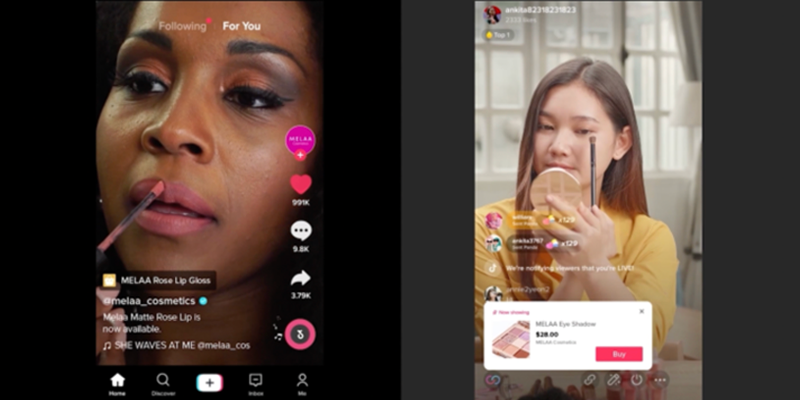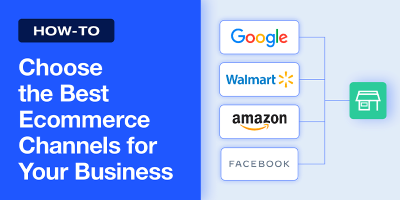With customer attention spans shrinking and the average user being bombarded with at least 6,000 ads a day, it is crucial for online merchants to embrace innovations in ecommerce and not get left behind. Social media platforms are working to help brands meet their customers at the right place and time so that shopping becomes seamless.
With social commerce on the rise, we’ve provided insight into how social media shopping has transformed the customer journey. Charlie Lozner, Partner and VP of Digital Marketing at Backbone Media (one of our Certified Agency Partners), shared his views on what makes social commerce special and how your brand can execute it successfully.
1. Customers are looking for instant gratification
In the oh-so-famous words of Ariana Grande, “I see it, I like it, I want it, I got it.” This sentiment has become more prevalent as social platforms evolve to allow users to easily purchase an item they see while scrolling through their feeds.
Embrace native checkout
More and more online platforms are working to develop a native checkout process. Native checkout is a feature designed to allow users to complete transactions wherever they are currently browsing. Rather than redirecting a customer off-site and potentially losing momentum on the sale, native checkout streamlines the purchase process by taking the user from “add to cart” to “place order” without interruption. Because frequent shoppers on a social network often save their payment info in the app, friction is minimized.
Examples of native checkout:
TikTok

Source: https://shop.tiktok.com/
Brands and sellers can now utilize TikTok Commerce to sell their products directly from a customer’s “for you” page. When you open a TikTok Shop, you can offer an entirely native shopping experience to your followers. In addition, Shopify users can integrate their Shopify shop with their TikTok account and sell directly to viewers when they go Live.
Related article: Tips for Succeeding in Ecommerce with TikTok
In 2020, Instagram released Checkout on Instagram, a feature that allows users to make purchases directly from their feed. “Shoppable posts” enable sellers to showcase their products organically by tagging items for sale in their photos or videos.
Related article: Tips for Selling Successfully with Checkout on Instagram
In March, Pinterest announced its latest advertising tool: hosted checkout. This feature enables merchants to show their checkout page within the Pinterest app, although it’s currently only available to Shopify users. Forty-six percent of weekly Pinterest users report having discovered a new brand or product on Pinterest. When paired with a seamless checkout process, those new discoveries can easily become new conversions.
We tend to work with a lot of brands that are trying to do three things:
- One, driving awareness for their brand to reach new audiences and create buzz.
- Two, driving category or product-level demand—i.e., what product is good for you?
- And three, ultimately capturing that demand. Once somebody has shown intent, or once somebody has spent some time on a product page, is there an offer that needs to go out to push that person to make a purchase?
2. Customers want brands to understand them
According to Accenture, customers say they are more likely to make purchases from brands that remember them and provide relevant offers exactly when they’re needed. Search engine optimization and remarketing have become key tools for achieving this, but brands should also invest time in improving their product data for social media algorithms. Managing your product data is a key to executing an omnichannel strategy that helps you reach more customers and deepen the customer-brand relationship.
Optimize your content for social media
One key to connecting with your customer is high-quality data. In addition to collecting first-party data from your existing customers, you should also be making your product data and content as accessible as possible.
Pinterest, for example, shows users a curated feed based on their interests and search history. By optimizing your product data, you can make sure to include all the search relevant information that algorithms use to match product ads to customers.
Twitter allows merchants to create dynamic product ads campaigns. These campaigns enable advertisers to retarget customers based on past behavior (e.g., visiting the add-to-cart page, viewing a product, or making a purchase), and they use product data to present the most relevant products to the customers who might be interested.
One of the most common mistakes a business makes is being a square peg in a circular hole, and not really paying attention to what best-in-class marketing, advertising, or creative look like on a particular channel. What works on Reddit is not going to work on Pinterest, and what works on YouTube is not going to work on TikTok. If you just pick up everything you’re doing on Instagram and try and port it over to TikTok, it’s not going to work. It might be fine or passable, but it’s certainly not optimized.
I think you need to determine what the most important channels are for you to execute on to reach your target audience. If you try and spread yourself over all the social channels, it’s going to be too big of a creative lift. So you want to do your research, figure out where your audiences are, really maximize your opportunity there, then establish some test budgets on other channels and see where to go next.
We can optimize your data for hundreds of shopping channels.
3. Customers want to buy from brands they can trust
Today, anyone can be an influencer, but brands that connect with the right content creators can tap into their existing credibility. User-generated content (UGC) is any product or brand-specific content created by people and not brands themselves. The authenticity of UGC contributes to a brand’s trustworthiness and provides a real-world look into the value of a product.
In 2021, 80% of social media live-stream viewers said they were more likely to purchase a product as a result of an endorsement from their favorite influencer. To capitalize on this trend, brands should make a conscious effort to build authenticity with genuine UGC.
Include UGC in your social commerce strategy
Getting started with UGC can be as simple as reposting content from your customers on social networks. Giveaways and hashtags prompt customers to share images of your products in action. Even if your products aren’t featured in a post, media that demonstrates the lifestyle associated with your products can be effective as well. For example, a boot company might share pictures from a customer’s ranch to signal authenticity.
Backbone Media has helped clients find social media success by sponsoring videos with authentic content creators and including their clients’ products. See how YETI coolers were casually included in a Bon Appétit video featuring legendary BBQ pitmaster, Rodney Scott, which garnered almost five million views on YouTube. Ooni pizza ovens were also used in a Pro Home Cooks video about making Neapolitan pizza, which resulted in over six million views.
I think influencer marketing is becoming a bigger piece of the mix, and it seems to sit higher in the funnel or earlier in the consumer journey. It’s probably less conversion oriented, but it can do a world of good for brands that are trying to reach new audiences and connect with them through a trusted source of content. It’s really fun when we can embed our brands authentically into some great content, so that it looks less and less like an advertisement, and more and more like an authentic piece of the storytelling.
4. Customers don’t want to be advertised to
A recent study found that Gen Z audiences were more receptive to branded content than previous generations. There has been a shift towards removing the idea of an “ad break” and having advertisements weaved seamlessly into the content being consumed. As we mentioned with UGC, customers are searching for authenticity from the products and brands they enjoy.
Focus on cultivating a community
Meta found that 41% of Gen Z users surveyed felt “more personally connected” when brands posted content that makes them feel like they are a part of the brand’s community. Brands should take this opportunity to cultivate a more personalized and genuine approach to social media marketing. Creating content that feels valuable and organic to the social channel is a great way to improve the user experience.
[Paid social] is integrated into the user’s experience in a way that just doesn’t happen with most other forms of advertising. If you’re doing connected TV, right when you get to the best point in the TV show, boom. Ninety seconds of commercials come in. Or when you’re trying to watch a YouTube video, you’ve just got to make it through to the skip button, and then the content that you want to watch is there. Print ads—you’re reading through a magazine, and there are other ads shoved in there. Same thing with display. On some websites, it’s over the top. You’ve got ads inserting from the top, pushing down, popping up, and videos playing that you didn’t ask for.
With social commerce, [ads] can be almost an enjoyable part of the experience.
Ready to get started with social commerce?
When done well, paid social ads are integrated in the rest of the content. In some cases, it can be the best execution of native advertising. If a brand is doing a really good job with creative, it adds to the user experience. The user of that social media platform is excited about what they’re seeing. Either it’s a brand they already know about, and they’d love to see new content and new products coming from them, or it’s a brand they’ve never heard about.
If the brand and the agency are doing a great job with the creative and the targeting, and the social platform is doing a job of getting the brand in front of the right user, you can have this magical moment where you find a brand you’ve never heard of.
Launching your brand on social media sounds easy. But if you’re trying to synchronize the same product data across Pinterest, TikTok, Instagram, and Facebook you’re going to run into a few problems. Each social media channel has different specifications and requirements you must follow to ensure your products appear. But doing the bare minimum doesn’t guarantee success.
At Feedonomics, our data feed specialists are experts on the requirements for hundreds of marketplaces and ad channels. Request a demo today and see how Feedonomics can give your ecommerce business a boost.

With its leading data feed management platform, Feedonomics helps brands, retailers, and agencies optimize and list products on hundreds of shopping destinations around the world. Learn more about our full-service solutions for advertising channels and marketplaces.





